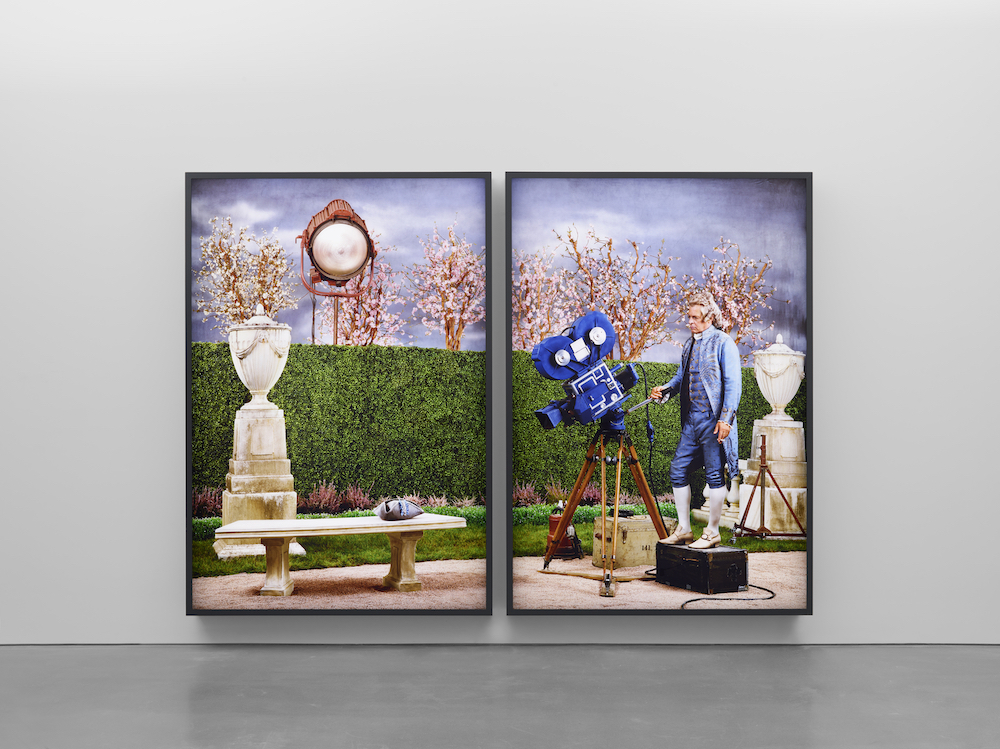Does humor belong in art? The late Canadian multimedia artist Rodney Graham evidently thought it did. But Graham’s humor, on display at the Lisson Gallery through March 23, is of the companionable sort: gentle, slightly self-deprecating, never sarcastic or cutting, yet fully aware of the delights of the absurd. It’s one of the friendliest shows in town.
The show self-divides into two very different Graham sensibilities, set across from one another like speed daters in the spacious, beautifully lit rooms of Lisson. Three enormous double-panel lightboxes, roughly 7 x 12 feet each, dramatize sharply focused color photos of Graham himself striking various poses. In one, he’s dressed as an 18th-century landowner, complete with wig and white stockings, yet with an incongruous cigarette in his left hand. In his right (speaking of incongruity), he holds the handle of a bright blue 35mm motion picture camera which is trained on a tricorne hat, evidently his own, on a marble bench. He’s not looking through the viewfinder, though. His face is hard to decipher—one sees traces of weariness, impatience, wistfulness. A klieg light illuminates the hat, but dark clouds glower above the scene, making it realistic and artificial at the same time.
The other light boxes present Graham in contemporary contexts. In one, Tattooed Man on Balcony, he stands alone; his apartment building could be anywhere in North America. As the title indicates, his arms and what we see of his chest are covered with tattoos, most of them depicting Popeye characters, including Wimpy and Olive Oyl. In another, Smoke Break 2 (Drywaller), Graham stands on the stilts used by housepainters and plasterers in a barely finished room. As in Tattooed Man, a nearly empty domestic space takes up most of the image, Graham’s body is carefully posed, and his face, again, has an air of weary impatience.
Both light boxes tempt the viewer to spin a narrative to account for this larger-than-life figure. Is Graham regarding us, or is his gaze aimed inward? Is he lonely, hence sad, or just alone, possibly content? What is he thinking at this moment? Graham’s giant gleaming photos suggest a wry awareness of the clash between the monumental and the quotidian, the two worlds in which every artist is forced to live.
The plaid shirt and jeans Graham wears in Smoke Break invoke something familiar, and the six large paintings do that, too, but in another language. They’re made with oil and sand, on linen, the sand giving them a rough surface reminiscent of stucco houses. Most are 6 x 5 feet, all untitled abstracts in restful colors ranging from muted to tropical. The shapes adhere to, flow into, or rub against each other in balanced, harmonious ways that reminded me of European Modernism’s greatest hits from a century ago.
The memory trigger is no accident. Lisson’s press release describes Graham’s process: “Starting from existing “source” paintings—by Aleksandr Rodchenko, Jean Arp, Morris Louis, Pablo Picasso and many others—each painted surface is built up by manipulating, scaling and shifting these components into satisfying arrangements…” I felt more Braque and Leger than Morris Louis, but I definitely saw the curves of Arp and the guitars of Picasso. Why not? With a muse as friendly as Rodney Graham’s, everyone’s invited to the party.


